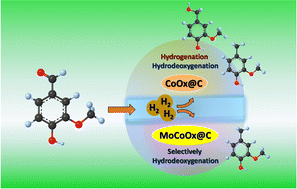Improving the hydrodeoxygenation activity of vanillin and its homologous compounds by employing MoO3-incorporated Co-BTC MOF-derived MoCoOx@C†
Abstract
Lignin-derived aryl ethers and vanillin are essential platform chemicals that fulfil the demands for renewable aromatic compounds. Herein, an efficient heterogeneous catalyst is reported for reforming vanillin via a selective hydrodeoxygenation route to 2-methoxy-4-methyl phenol (MMP), a precursor to medicinal, food, and petrochemical industries. A series of MoCoOx@C catalysts were synthesized by decorating the Co-BTC MOF with different contents of MoO3 rods, followed by carbonization. Among these catalysts, MoCoOx@C-2 afforded ∼99% vanillin conversion and ∼99% MMP selectivity at 150 °C in 1.5 h in an aqueous medium. In contrast, CoOx@C afforded ∼75% vanillin conversion and ∼85% MMP selectivity. Detailed catalyst characterization revealed that CoOx and Co2Mo3O8 were the active species contributing to the higher activity of MoCoOx@C-2. The excellent H2-adsorption characteristics and acidity of MoCoOx@C-2 were beneficial to the hydrodeoxygenation of vanillin and other homologous compounds. The DFT adsorption energy calculations suggested the favourable interactions of vanillin and vanillyl alcohol with the Co2Mo3O8 sites in MoCoOx@C-2. The catalyst could be efficiently recycled 5 times, with a negligible loss in activity after the 5th cycle. These findings provide a systematic explication of the active sites of the mixed metal oxide-based MoCoOx@C-2 catalyst for the selective hydrodeoxygenation of vanillin to MMP, which is important for the academic and industrial catalysis community.



 Please wait while we load your content...
Please wait while we load your content...